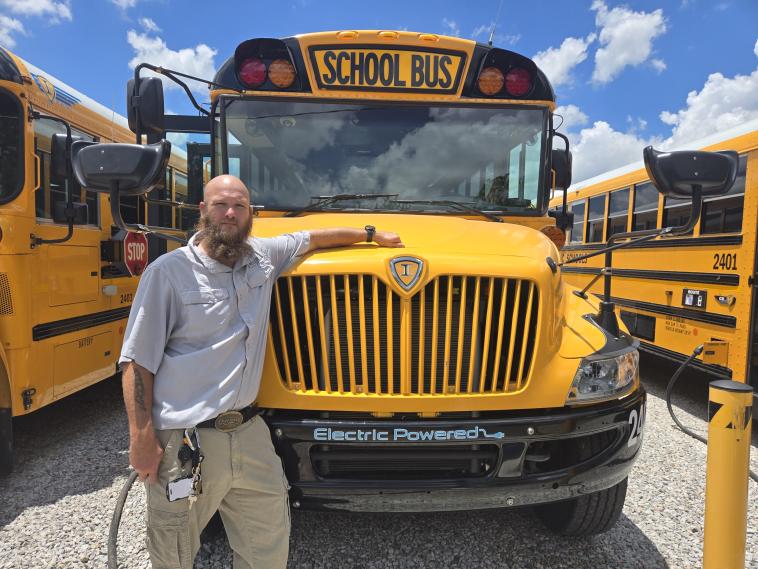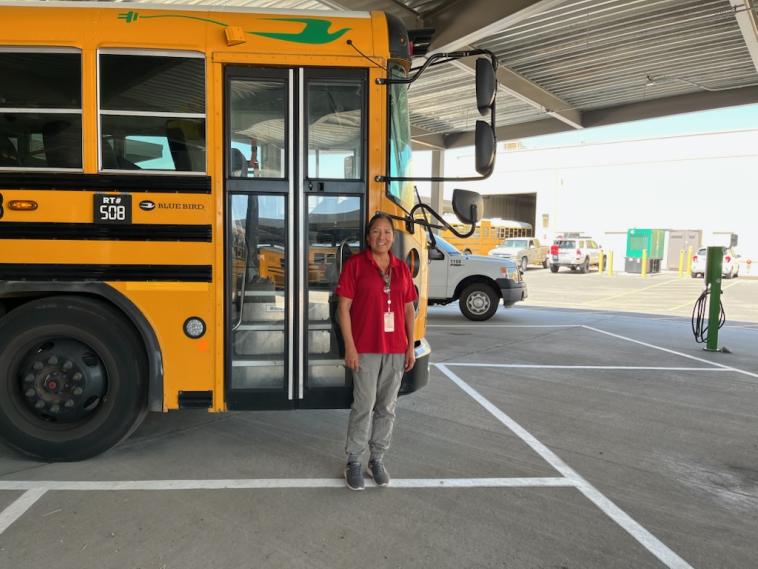Drivers Reap the Benefits of Electric School Buses
School bus drivers are experiencing the health benefits of a cleaner, zero-tailpipe-emissions ride firsthand and learning about the switch to electric vehicles on the job.

Steve Easterday would start and end the school year with the windows open. In the fall and spring, when the weather turned temperate in central Tennessee, his passengers – Putnam County Schools students of all ages – would slide down the windows. That was when his headaches would start.
Easterday, who has driven school buses for the 12,000-student district for a decade, always figured that the seasonal pollen drifting through the open windows was to blame. But when the county introduced its first electric school buses two years ago, he noticed that switching from diesel-burning buses to electric brought immediate changes: There was no more diesel fume smell on his clothes or oil spilled on his skin after checking the dipstick. And after about 90 days with his new bus, he realized something was missing — his biannual headache.
“I remember thinking, why would that be?” Easterday told WRI. “Then it just occurred to me ... it wasn’t a pollen headache – it was a diesel headache.”
Electric school buses are hitting the road in city centers, rural counties and suburban communities across the United States. State and federal funding has made a clean ride for kids more affordable for school districts, with almost 5,000 electric school buses now operating in 49 states, more than four U.S. territories and 55 tribal nations. The transition to electric school buses affects hundreds of members of a community, from students and parents to teachers and transportation staff.
School bus drivers – most of whom began their driving careers with diesel-burning buses – are at the forefront of the transition. They’re experiencing the health benefits of a cleaner, zero-tailpipe-emissions ride firsthand and learning about the switch to electric vehicles on the job. WRI spoke with five drivers from three states about their personal experiences transitioning from diesel-burning school buses to electric ones.
The Benefits of Driving an Electric School Bus
Electric school buses are a cleaner and healthier alternative for many districts looking to prioritize student and environmental health. For generations, millions of children in the U.S. have relied on the iconic yellow bus to get to school. But most of those buses are also easily identified by the potent black fumes trailing from their tailpipe. That’s diesel exhaust pollution – an air pollutant so harmful that the World Health Organization labels it as a known carcinogen. Diesel exhaust can cause asthma, cancer and respiratory issues for everyone, but it’s especially harmful for children and their developing lungs.
But children aren’t the only ones on school buses daily, and they’re not the only riders who notice the difference when diesel exhaust disappears. With many drivers spending hours on the road, exposure adds up. Easterday, for example, drives 25 miles during his morning route, while Nachol Trone and Margarita Villabolos, both drivers for the Salt Lake City School District, are on their buses for roughly 86 miles and 60 miles a day, respectively. Route lengths vary by district and state, but one study of three representative states found that the average daily school bus route is 32 miles.
All five of the electric school bus drivers who spoke with WRI noted the benefits of eliminating diesel exhaust in their daily commute, including improved air quality and reduced emissions exposure. Shawnee Public Schools in central Oklahoma added two electric school buses to its fleet in 2023, now driven by longtime drivers Thomas Wondrock and Ron Reser. These electric school buses “are fairly well sealed,” Wondrock said. Even when idling in the electric school bus behind a running diesel bus, with all the doors and windows closed, he doesn’t smell the diesel as much, he explained. On mild days, he can now slide down the windows and let the air circulate.
“On diesel buses, you really tried not to do that because when you came to a stop, it would stink and get in the bus,” Wondrock said.
With the electric bus, Trone noticed the absence of diesel fumes even before starting her route. She recalled how, during the pre-trip inspections of her old diesel bus to ensure it was fit for use, she could smell the fumes as soon as she stepped outside.
“Just think that you’re on the bus every day, and the kids roll down the window … all those fumes coming in. That’s pretty bad,” said Trone, who has driven school buses for the Salt Lake City School District for 21 years. “I think in general, everybody’s going to feel better not breathing that every single day all day long.”

Villalobos has been driving school buses for 18 years and made the switch to an electric school bus four years ago.
“When you stop somewhere [with the electric bus] you don’t have to turn it off, because you’re not contaminating the air,” she said. “ ... With the smell of the diesel, I feel a little sick, versus with the electric buses. It makes a big difference.”
A Quieter Ride
Diesel-burning school buses produce noise levels at or above 85 decibels, exceeding the Environmental Protection Agency’s recommended noise exposure limit of 80 decibels for children. A recent survey from Highland Electric Fleets found that two-thirds of U.S. parents “believe that reducing stressors like diesel fumes and noise during the school commute can help support their child's emotional and academic success.” Some school districts have found that an electric school bus led to a reduction in behavioral disruptions. In Shawnee Public Schools, behavioral write-ups dropped by 50% on the bus routes that switched to electric.
Drivers like Reser, who’s been driving for Shawnee Public Schools for 12 years, mentioned noise reduction as a noteworthy benefit of electric school buses. These buses are generally “a lot quieter [and] they don’t vibrate as much … you can hear the kids in the back talking now with no diesel engine running,” he said. This is especially helpful for students with sensory and learning needs. Some children with noise sensitivities stopped riding the school’s diesel buses because the noise would be too overwhelming, Reser said.

Now, half of Shawnee’s fleet is electric – including two accessible buses – and students with diverse mobility, sensory and learning needs can ride the buses without issue. “We are able to meet their needs,” said Wondrock.
Trone found near-immediate relief after switching to the electric school bus. She realized just how much the diesel-engine noise had been hurting her ears.
“The buzzing and the humming of the engine – I feel like it has affected my hearing,” she said. “With the electric school bus, it’s so quiet, you can hear so much better.”
There was also an unexpected relational benefit of reduced noise on the bus: improved communication with parents. When Wondrock was driving diesel-burning buses, he often had to shout over the engine to speak with parents, but now, "we're able to have civilized conversations with parents, which makes us happier, makes parents happier … we have a bunch of better relationships with our students and our parents now,” he said.
Adapting to the Electric Shift
Transitioning from diesel-burning to electric school buses was a learning curve for some drivers, especially adjusting to the lighter acceleration, but most quickly adapted to the new technology.
Features like regenerative braking help extend battery life by using the kinetic energy created by decelerating downhill or braking. Using this feature, Easterday often finishes his route with more than 90% charge remaining. In springtime weather in Tennessee, his range can exceed 140 miles on a charge. Even in the colder months when the range drops to around 100 miles, it’s never caused him an issue, he said.

Even in challenging terrain, such as the hilly Salt Lake City routes, the Salt Lake City School District has found that driving down a mountain pass at 55 miles to 57 miles per hour can result in a 16% to 17% in-route battery gain.
Reser and Wondrock at Shawnee Public Schools experienced several charging issues when they first began driving the new electric buses. Although no longer an issue for the school district, at times the buses weren’t charging as much as needed overnight.
Transportation challenges however aren’t unique to electric school buses, the Shawnee drivers pointed out: Any new technology, electric or not, can require initial troubleshooting. Before Wondrock switched to an electric school bus, he received a brand-new diesel-burning bus that completely shut down while driving after the ignition switch fell out from behind the dash, triggering alarms and scaring the children.
Electric Buses for a Better Work Experience
All the drivers who spoke to WRI said they preferred the electric school bus over the diesel-burning buses. While diesel buses still have some benefits, such as quick refueling and longer range, Trone said the switch was worth it.
“The exhaust alone is such a relief to not have to worry about,” she said. “You used to go home at the end of the day [smelling] like exhaust.”
She’s not looking back. “I already told [the transportation director], I’m taking my bus next year, I’m not giving it to anyone else,” she added.
For school bus drivers like Reser, the shift to electric is more than just a change of vehicle: It’s a better daily work experience. “This is the future,” Reser said. “We want to be a part of leading it.”
As more school districts consider making the switch to electric, the drivers’ experiences highlight the real-life benefits of cleaner, electric school buses, from improved air quality and quieter trips to greater job comfort. The renewable energy transition can deliver not just environmental benefits but day-to-day improvements for the riders – children, drivers and staff – who rely on the yellow school buses every day.